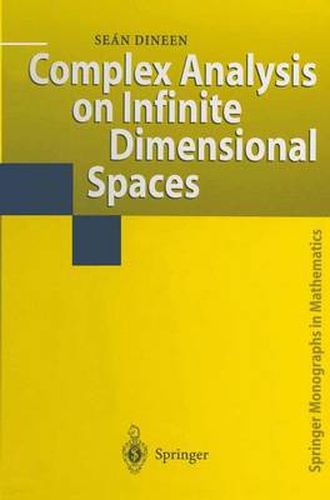Readings Newsletter
Become a Readings Member to make your shopping experience even easier.
Sign in or sign up for free!
You’re not far away from qualifying for FREE standard shipping within Australia
You’ve qualified for FREE standard shipping within Australia
The cart is loading…






This title is printed to order. This book may have been self-published. If so, we cannot guarantee the quality of the content. In the main most books will have gone through the editing process however some may not. We therefore suggest that you be aware of this before ordering this book. If in doubt check either the author or publisher’s details as we are unable to accept any returns unless they are faulty. Please contact us if you have any questions.
Infinite dimensional holomorphy is the study of holomorphic or analytic func tions over complex topological vector spaces. The terms in this description are easily stated and explained and allow the subject to project itself ini tially, and innocently, as a compact theory with well defined boundaries. However, a comprehensive study would include delving into, and interacting with, not only the obvious topics of topology, several complex variables theory and functional analysis but also, differential geometry, Jordan algebras, Lie groups, operator theory, logic, differential equations and fixed point theory. This diversity leads to a dynamic synthesis of ideas and to an appreciation of a remarkable feature of mathematics - its unity. Unity requires synthesis while synthesis leads to unity. It is necessary to stand back every so often, to take an overall look at one’s subject and ask How has it developed over the last ten, twenty, fifty years? Where is it going? What am I doing? I was asking these questions during the spring of 1993 as I prepared a short course to be given at Universidade Federal do Rio de Janeiro during the following July. The abundance of suit able material made the selection of topics difficult. For some time I hesitated between two very different aspects of infinite dimensional holomorphy, the geometric-algebraic theory associated with bounded symmetric domains and Jordan triple systems and the topological theory which forms the subject of the present book.
$9.00 standard shipping within Australia
FREE standard shipping within Australia for orders over $100.00
Express & International shipping calculated at checkout
This title is printed to order. This book may have been self-published. If so, we cannot guarantee the quality of the content. In the main most books will have gone through the editing process however some may not. We therefore suggest that you be aware of this before ordering this book. If in doubt check either the author or publisher’s details as we are unable to accept any returns unless they are faulty. Please contact us if you have any questions.
Infinite dimensional holomorphy is the study of holomorphic or analytic func tions over complex topological vector spaces. The terms in this description are easily stated and explained and allow the subject to project itself ini tially, and innocently, as a compact theory with well defined boundaries. However, a comprehensive study would include delving into, and interacting with, not only the obvious topics of topology, several complex variables theory and functional analysis but also, differential geometry, Jordan algebras, Lie groups, operator theory, logic, differential equations and fixed point theory. This diversity leads to a dynamic synthesis of ideas and to an appreciation of a remarkable feature of mathematics - its unity. Unity requires synthesis while synthesis leads to unity. It is necessary to stand back every so often, to take an overall look at one’s subject and ask How has it developed over the last ten, twenty, fifty years? Where is it going? What am I doing? I was asking these questions during the spring of 1993 as I prepared a short course to be given at Universidade Federal do Rio de Janeiro during the following July. The abundance of suit able material made the selection of topics difficult. For some time I hesitated between two very different aspects of infinite dimensional holomorphy, the geometric-algebraic theory associated with bounded symmetric domains and Jordan triple systems and the topological theory which forms the subject of the present book.